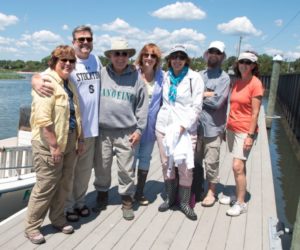Join Us for a HEROtini Night in Somers Point!
July 21, 2017Preparing for a Hurricane
September 8, 2017

Perched on a ladder, President Harvey Kesselman peered into a nesting platform, a tall wooden post topped with a bed of sticks towering above the vast saltmarsh. Two orange-eyed, downy osprey nestlings gazed back at him while their parents circled overhead.
“These are the chicks!†he said in amazement of their size.
From their vantage point in the saltmarsh, Kesselman and the chicks had a straight shot view of the Atlantic City skyline and could almost see the site of the Stockton osprey’s new campus.
Stockton was invited by Thomas “Tim†Glenn III, president of Glenn Insurance and a Stockton University Foundation Board member, to join Ben Wurst, habitat program manager for the Conserve Wildlife Foundation of New Jersey (CWFNJ), to survey osprey nests along Absecon Creek. This year, CWFNJ’s New Jersey Osprey Project is conducting a statewide census of nesting ospreys.
Glenn, a wildlife advocate, has supported CWFNJ’s conservation efforts and is an environmental steward who participates in local projects with his three children ranging from repurposing beetle-damaged wood into nesting platforms to banding migrating shorebirds. From the marsh, he pointed to the Glenn Insurance building in Absecon. For years, he has rescued terrapins from danger in the parking lot where he works and has helped salvage eggs from road-killed females. At one time, he had a terrapin rearing facility in his family kitchen. When he was introduced to John Rokita, a wildlife rehabilitator at Stockton, his terrapin rescues moved to Stockton’s lab.
For the osprey survey, Kesselman was joined by his wife, Lynne, Susan Davenport, executive vice president, Lori Vermeulen, provost, John Rokita, principal lab technician, Lester Block, a professional services specialist, and Elizabeth Bick-Zimmermann, a Marine Field Station assistant who served as captain for the ride through the creek.
In the nest, the chicks hunkered into tightly woven twigs and marsh materials, blending seamlessly in an attempt to become invisible to predators from above.
Wurst pointed out a tan, twig-like stripe that runs along their backs, a natural camouflage helping them disappear into the nest.
From the opposite ladder, Wurst climbed down, carefully holding a chick in one hand. He pulled out a string of metal lock-on bands designed for raptors. In seconds, the chick was banded, sporting its new anklet inscribed with a unique string of numbers.
During the brief banding session, the chick played dead in Wurst’s hand, as instructed by its parents calling nearby.
Shortly after the group pulled away in two boats, the parents returned to the nest.
A section of Absecon Creek with about a dozen nesting platforms installed along the banks is known as Osprey Alley. The group surveyed a number of the nests seeing chicks of varying ages.
Lynne Kesselman climbed up a ladder to see a one-week-old chick. “Oh my gosh. It’s so cute,†she reacted with a big smile.
Kesselman saw her first osprey driving on the parkway after leaving campus many years ago. She was looking for a big nest that was located on the southbound side and found an osprey perched on top of a nearby telephone pole.
Lori Vermeulen saw her first osprey in Yellowstone National Park. Susan Davenport recalled her most unique osprey sighting when she watched an eagle steal a fish from an osprey while white-water rafting down the Snake River. Her river guide had just explained eagle and osprey interactions when one unfolded in front of her eyes.
The nesting survey offered once-in-a-lifetime, bird’s-eye-views, unless you are Ben Wurst, who welcomes South Jersey’s osprey broods year after year and watches them grow up throughout the season. Wurst and a handful of trained volunteers conduct annual surveys to monitor the state’s osprey population.
When Stockton selected the osprey as its mascot in the early 1970s, it was listed as a state-endangered species by the New Jersey Division of Fish, Game and Wildlife. In 1974, nests had fallen to an all-time low of 53 from nearly 500 nests in previous years. Habitat loss, increased predator populations and the chemical DDT caused the decline, but the installation of nesting platforms and monitoring efforts reversed the decline. In 2009, the nesting pair number reached 486.
John Rokita and Lester Block, both avid birders, pointed out other saltmarsh species during the survey including nesting laughing gulls, willets, a clapper rail and a few common terns dive-bombing an osprey that came too close to their nests.
An injured terrapin with a cracked shell, most likely struck by a boat propeller, crawled out of a depression in the marsh. Lucky for her, Rokita took her back to Stockton’s lab for care.
The osprey survey revealed a number of healthy chicks that will grow up this summer and head south in the early fall.
See the full photo gallery here >>Â
To learn more about ospreys and how to volunteer, visit ConserveWildlifeNJ.org.
Learn how to contribute observation by becoming an osprey watcher at www.osprey-watch.org.
Thank you to Stockton University for this article and the photos! Â

 Get a Quote
Get a Quote